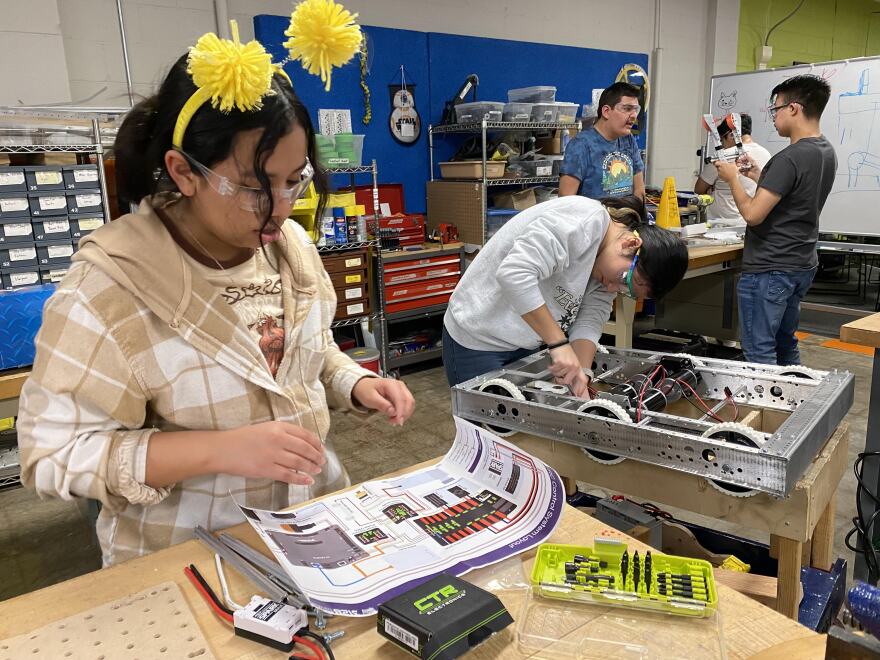Kansas City is deeply involved in remaking the warheads that stock the U.S. nuclear arsenal. A plant on the southern edge of the city makes most of the non-nuclear parts for nuclear weapons. That plant is expanding rapidly, spreading billions of federal dollars around the metropolitan area.
To re-arm the United States for Armageddon — or the display of brute, nuclear strength needed to stave it off — it turns out you need to sort out the parking problem.
But America’s in a hurry to replace old nuclear warheads before they turn into duds, or something radioactively worse. So it’s leaning on shuttles to bring in the workers it can’t get enough of to this plant on the south edge of Kansas City.
The Kansas City National Security Campus runs 24/7 making 80% of the non-nuclear parts for nuclear weapons. It needs to run faster.
“We’re at about 6,500 people today, and our intent is to continue to grow to about 7,000” by the end of September, said Eric Wollerman, the president of federal manufacturing and technologies for Honeywell.
That’s nearly triple the number of people who worked here just a few years ago. It makes Honeywell one of the largest manufacturing employers in Missouri.
By comparison, Ford’s Kansas City Assembly plant, one of the most productive auto plants in the country, employs about 7,800 making F-150 pickups and Transit Vans.
The output at the campus is minuscule by automotive industry standards. But a Ford F-150 doesn’t have to deter a Russian nuclear attack. The nuclear warhead components made in Kansas City do.
“There’s a lot of sophisticated electronics, you know, timers, fuses, conventional explosives that help the nuclear explosives go off,” says Eugene Gholz, a political science professor at the University of Notre Dame. “Somebody’s got to make it in a very high-precision way and in a very secure way so that other people don’t know about it, can’t disrupt it. It’s super classified.”

That work has been happening in Kansas City since the Cold War. The problem is, most of the 3,750 ready-to-use nuclear bombs and warheads in the U.S. arsenal date back decades. They weren’t designed to last this long. And Gholz says out-of-date nukes are dangerous.
“If you have bits solder together on a printed circuit board, the solder moves over time. It has some liquid characteristics, so it shorts, and so you have to replace it,” said Gholz. “There’s just a million little things.”
So the government has launched a massive, 10-year, $600 billion-plus effort to refurbish, upgrade or replace most of the nuclear arsenal. That includes a new stealth bomber, the B-21 Raider that’s likely to be stationed an hour east of Kansas City at Whiteman Air Force Base. It includes new submarines and new intercontinental ballistic missiles. It calls for new warheads, and for modernizing or refurbishing old ones. That mandate is fueling the big ramp-up at the nuclear parts factory in Kansas City.
The plant already pipes a lot of Washington money into the regional economy. The payroll is just under $550 million and growing. It buys from 460 Kansas and Missouri businesses.
But the security campus expansion is running up against the tightest labor market in 50 years. Wollerman says he’s trying to fill 600 open positions. Hiring is his top challenge.
“We’re in a growth environment and we need to sustain the mission,” Wollerman said. “You can’t execute it without your people.”
The facility has a well-established talent pipeline. It draws from places like a windowless workshop on Troost Avenue, the Kansas City Engineering Zone, where teams from four urban high schools design and build robots to compete in regional competitions. Martha McCabe, who directs the KC STEM Alliance, says the robot classroom is equipped almost entirely with machined donated by the Kansas City National Security Campus.
“All this equipment,” she said, motioning around the shop, “you have drill presses, you have lathes, you have a horizontal band saw, a sheet metal brake press.”

McCabe says the KCNSC is one of its biggest donors, in for more than $50,000 a year. It also pays its engineers to mentor these urban core high school students. And she says the plant offers jobs with starting wages that can reach $35 an hour, for people with a high school education. And room for advancement.
“One hundred percent a path out of poverty,” McCabe said. “And not only for the individual but for their family.”
The job requires careful attention to detail, U.S. citizenship, and a clean enough record to gain a U.S. Department of Energy security clearance.
With that in hand, local kids can make a middle-class living making parts for some of the most deadly weapons on Earth.
Don’t miss a beat … Click here to sign up for our email newsletters
Click here to learn more about our newsletters first








